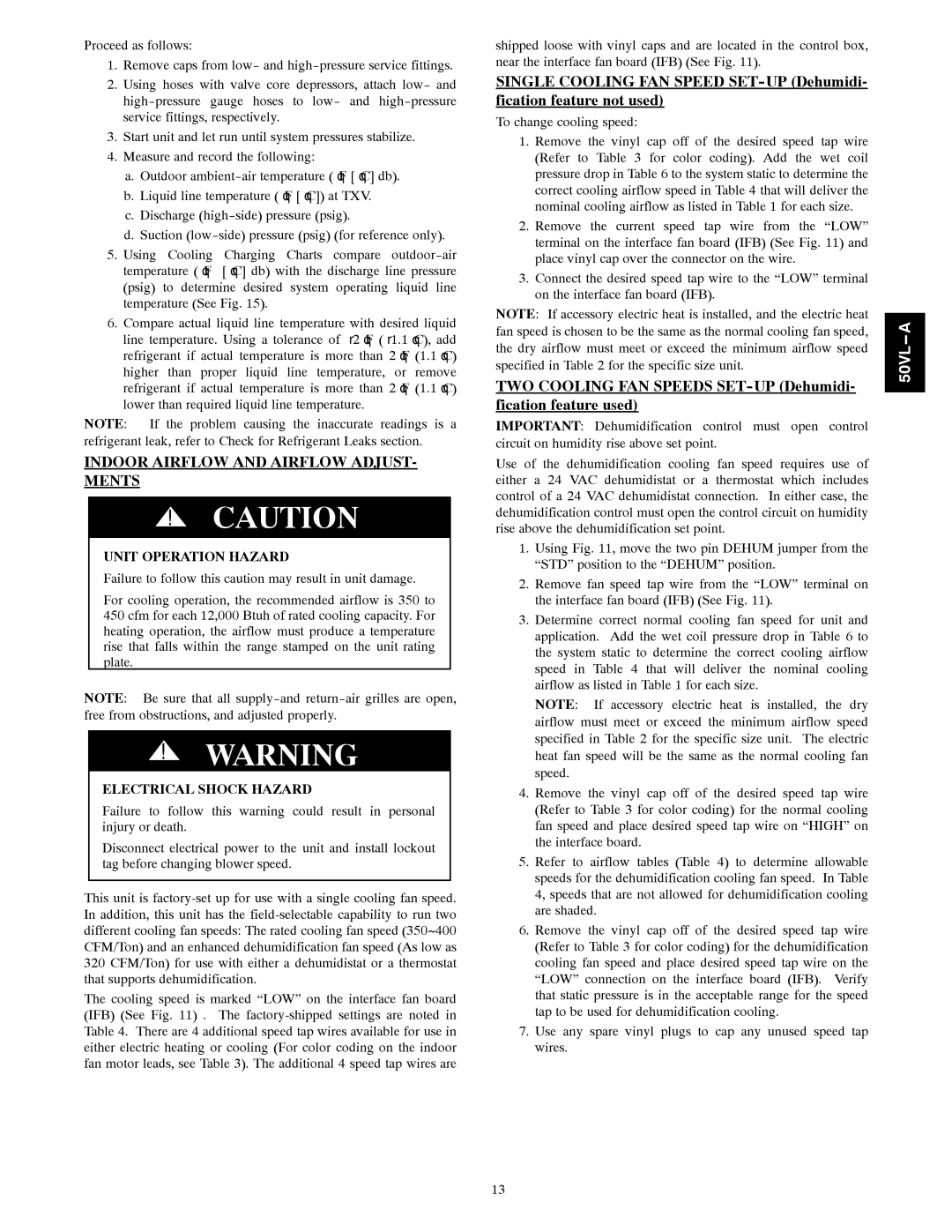Proceed as follows:
1.Remove caps from low- and high-pressure service fittings.
2.Using hoses with valve core depressors, attach low- and high-pressure gauge hoses to low- and high-pressure service fittings, respectively.
3.Start unit and let run until system pressures stabilize.
4.Measure and record the following:
a.Outdoor ambient-air temperature (°F [°C] db).
b.Liquid line temperature (°F [°C]) at TXV.
c.Discharge (high-side) pressure (psig).
d.Suction (low-side) pressure (psig) (for reference only).
5.Using Cooling Charging Charts compare outdoor-air temperature (°F [°C] db) with the discharge line pressure (psig) to determine desired system operating liquid line temperature (See Fig. 15).
6.Compare actual liquid line temperature with desired liquid line temperature. Using a tolerance of ±2°F (±1.1°C), add refrigerant if actual temperature is more than 2°F (1.1°C) higher than proper liquid line temperature, or remove refrigerant if actual temperature is more than 2°F (1.1°C) lower than required liquid line temperature.
NOTE: If the problem causing the inaccurate readings is a refrigerant leak, refer to Check for Refrigerant Leaks section.
INDOOR AIRFLOW AND AIRFLOW ADJUST- MENTS
!CAUTION
UNIT OPERATION HAZARD
Failure to follow this caution may result in unit damage.
For cooling operation, the recommended airflow is 350 to 450 cfm for each 12,000 Btuh of rated cooling capacity. For heating operation, the airflow must produce a temperature rise that falls within the range stamped on the unit rating plate.
NOTE: Be sure that all supply-and return-air grilles are open, free from obstructions, and adjusted properly.
!WARNING
ELECTRICAL SHOCK HAZARD
Failure to follow this warning could result in personal injury or death.
Disconnect electrical power to the unit and install lockout tag before changing blower speed.
This unit is factory-set up for use with a single cooling fan speed. In addition, this unit has the field-selectable capability to run two different cooling fan speeds: The rated cooling fan speed (350~400 CFM/Ton) and an enhanced dehumidification fan speed (As low as 320 CFM/Ton) for use with either a dehumidistat or a thermostat that supports dehumidification.
The cooling speed is marked “LOW” on the interface fan board (IFB) (See Fig. 11) . The factory-shipped settings are noted in Table 4. There are 4 additional speed tap wires available for use in either electric heating or cooling (For color coding on the indoor fan motor leads, see Table 3). The additional 4 speed tap wires are
shipped loose with vinyl caps and are located in the control box, near the interface fan board (IFB) (See Fig. 11).
SINGLE COOLING FAN SPEED SET-UP (Dehumidi-
fication feature not used)
To change cooling speed:
1.Remove the vinyl cap off of the desired speed tap wire (Refer to Table 3 for color coding). Add the wet coil pressure drop in Table 6 to the system static to determine the correct cooling airflow speed in Table 4 that will deliver the nominal cooling airflow as listed in Table 1 for each size.
2.Remove the current speed tap wire from the “LOW” terminal on the interface fan board (IFB) (See Fig. 11) and place vinyl cap over the connector on the wire.
3.Connect the desired speed tap wire to the “LOW” terminal on the interface fan board (IFB).
NOTE: If accessory electric heat is installed, and the electric heat fan speed is chosen to be the same as the normal cooling fan speed, the dry airflow must meet or exceed the minimum airflow speed specified in Table 2 for the specific size unit.
TWO COOLING FAN SPEEDS SET-UP (Dehumidi-
fication feature used)
IMPORTANT: Dehumidification control must open control circuit on humidity rise above set point.
Use of the dehumidification cooling fan speed requires use of either a 24 VAC dehumidistat or a thermostat which includes control of a 24 VAC dehumidistat connection. In either case, the dehumidification control must open the control circuit on humidity rise above the dehumidification set point.
1.Using Fig. 11, move the two pin DEHUM jumper from the “STD” position to the “DEHUM” position.
2.Remove fan speed tap wire from the “LOW” terminal on the interface fan board (IFB) (See Fig. 11).
3.Determine correct normal cooling fan speed for unit and application. Add the wet coil pressure drop in Table 6 to the system static to determine the correct cooling airflow speed in Table 4 that will deliver the nominal cooling airflow as listed in Table 1 for each size.
NOTE: If accessory electric heat is installed, the dry airflow must meet or exceed the minimum airflow speed specified in Table 2 for the specific size unit. The electric heat fan speed will be the same as the normal cooling fan speed.
4.Remove the vinyl cap off of the desired speed tap wire (Refer to Table 3 for color coding) for the normal cooling fan speed and place desired speed tap wire on “HIGH” on the interface board.
5.Refer to airflow tables (Table 4) to determine allowable speeds for the dehumidification cooling fan speed. In Table 4, speeds that are not allowed for dehumidification cooling are shaded.
6.Remove the vinyl cap off of the desired speed tap wire (Refer to Table 3 for color coding) for the dehumidification cooling fan speed and place desired speed tap wire on the “LOW” connection on the interface board (IFB). Verify that static pressure is in the acceptable range for the speed tap to be used for dehumidification cooling.
7.Use any spare vinyl plugs to cap any unused speed tap wires.

